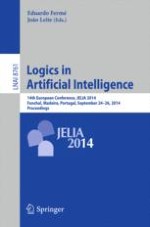This book constitutes the proceedings of the 14th European Conference on Logics in Artificial Intelligence, JELIA 2014, held in Funchal, Madeira, Portugal, in September 2014. The 35 full papers and 14 short papers included in this volume were carefully reviewed and selected from 121 submissions. They are organized in topical sections named: description logics; automated reasoning; logics for uncertain reasoning; non-classical logics; answer-set programming; belief revision; dealing with inconsistency in ASP and DL; reason about actions and causality; system descriptions; short system descriptions; and short papers. The book also contains 4 full paper invited talks.
